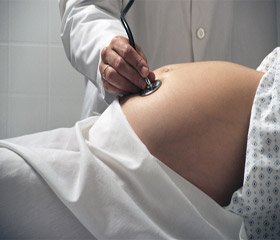Журнал «Медико-социальные проблемы семьи» 4 (том 18) 2013
Вернуться к номеру
Peculiarities of the antenatal course of multiple pregnancy after the use of assisted reproductive technologies
Авторы: L.H. Boichuk, L.M. Vakaliuk, L.V. Drohomyretskyi, V.O. Liubinets, V.I. Yunger - Ivano-Frankivsk National Medical University
Рубрики: Акушерство и гинекология
Разделы: Клинические исследования
Версия для печати
In recent years multiple pregnancy and multiple birth have become one of the burning issues of the contemporary obstetrics. As it is known, multiple pregnancy and multiple birth more often go together with obstetrical and perinatal complications. The most frequent complications of multiple pregnancy are the noncarrying of pregnancy and anemia of pregnancy in every second woman, late gestosis (in every fifth woman), hydramnion. With multiple pregnancy there is a high risk of perinatal pathology of the newborn, which increases significantly in case of extracorporeal fertilization. Effective and opportune assistance and work of the antenatal service contributes to the solution of tasks aimed at the preservation of reproductive health and the reduction of maternal and perinatal mortality
multiple pregnancy, infertility, noncarrying of pregnancy.
Research Materials and Methods
To accomplish the set task, we have made clinical and paraclinical analysis of outpatient medical cards and labor case records of 120 women divided into two main groups: Group I of 40 women with long treated infertility included in the IVF program, Group II of 40 women with infertility associated with primary endocrine dysfunction, where stages of combined hormonal correction and controlled ovulation induction were used. The said groups of patients have been compared between themselves and with the reference group of women (30 women), whose pregnancy showed no clinical picture of gestational complications.
Besides, transvaginal sonography was used to measure the length of the uterine cervix, the dilatation of the internal orifice of the uterus as well as the back angle of the uterine cervix, and the cervical consistency index was calculated.
Research Results and Their Discussion.
According to various data, 35% of the pregnancies resulting from assisted reproductive technologies are multiple pregnancies. The majority of the examined women are aged between 30 and 45, which is the most active reproductive period of a young woman. When analyzing the age-related peculiarities, it has been established that in Group I a clearly bigger number of women (50.0±3.73 %) fall within the prognosticly unfavorable age groups – above 35 years (р≤0.05).
The results of study of anamnestic data have shown the importance of the peculiarities and nature of menstruation (opsomenorrhea or menometrorrhagia, apparent premenstrual syndrome, secondary amenorrhea), which reflects hormonal imbalance, the number of pregnancies and labors in anamnesis as well as the number of artificial and natural abortions and surgeries of small pelvis organs suffered in anamnesis, postabortal and postnatal complications. It should be noted that surgeries of reproductive organs in anamnesis occurred twice more often (р≤0.05) in the group of infertile women included in the IVF program. In women with treated infertility primary placental insufficiency was diagnosed already in the first half of pregnancy and three times more often in women with infertility associated with primary endocrine dysfunction, where stages of combined hormonal correction and controlled ovulation induction were used (35.0±3.77 % vs. 13.33±2.53 %) (р<0.05).
After 20 weeks of pregnancy the said category of women is also characterized by a significant percentage of noncarrying of pregnancy, mainly due to undiagnosed isthmic-cervical insufficiency as well as placental dysfunction. In the pregnant women of Group I the signs of isthmic-cervical insufficiency were diagnosed three times more often (11 patients 27.2% vs. 5 cases – 10.4%), which ensured optimal time of diagnosing and surgical correction.
In the 3d trimester of pregnancy we have observed an increased percentage of such complications as preeclampsia of various degrees of severity, including severe atypical forms, which prevailed in Group I and made up 17,82±3,81 % vs. 13,48±3,62 % .
The analysis of the condition of children born by such mothers shows that every third child suffers from hypoxia of various degrees of severity. Signs of antenatal hypotrophy can be observed in every fifth child born by a mother treated with assisted reproductive technologies and every third child born by a previously infertile mother.
Conclusions
The results of the conducted clinical-statistical research suggest that a complicated course of multiple pregnancy is related to hormonal overcharge, placental insufficiency, isthmic-cervical insufficiency that was not diagnosed in due time. A thorough supervision and timely correction of complications may ensure a favorable course of pregnancy and birth of a healthy child by the above described pregnant women.
1. Vdovychenko Y.P., Tkachenko А.V. Clinical-Statistical Features of Multiple Pregnancy at the Contemporary Stage // Visnyk Naukovykh Doslidzhen. – 2005. – No. 2. – P.10-13.
2. Holota V.Y., Beniuk S.V., Tahaichynova S.V. Ultrasound Diagnosing in the Prognosis of the Course of Multiple Pregnancy and Labor // Pediatrics, Obstetrics and Gynecology. – 2005. – No. 1. – P.83-85.
3. Kulakov V.I., Leonov B.V. Extracorporeal Fertilization and Its New Trends in Treating Female and Male Infertility. Moscow.: MIА, 2002. – 782 p.
4. Romanenko T.H., Zavadskaya O.Y. Peculiarities of Course of Multiple Pregnancy and Labor // Woman’s Reproductive Health. – 2004. – No. 1(17). – P. 67-69.
5. Tkachenko А.V. Course and Consequences of Multiple Gestations in a Comparative Aspect // Pediatrics, Obstetrics and Gynecology. – 2005. – No. 3. – P. 89-95.
1. Vdovychenko Yu.P., Tkachenko A.V. Kliniko-statystychni rysy bahatopliddya na suchasnomu etapi // Visnyk naukovykh doslidzhen'. – 2005. – #2. – S.10-13.
2. Holota V.Ya., Benyuk S.V., Tahaychynova S.V. Ul'trazvukova diahnostyka v prohnozuvanni perebihu vahitnosti ta polohiv pry bahatopliddi // Pediatriya, akusherstvo ta hinekolohiya. – 2005. – #1. – S.83-85.
3. Kulakov V.Y., Leonov B.V. Эkstrakorporal'noe oplodotvorenye y eho novыe napravlenyya v lechenyy zhenskoho y muzhskoho besplodyya. M.: MYA, 2002. – 782 s.
4. Romanenko T.H., Zavadskaya O.Yu. Osobennosty techenyya beremennosty y rodov pry mnohoplodnoy beremennosty // Reproduktyvnoe zdorov'e zhenshchynы. – 2004. – #1(17). – S. 67-69.
5. Tkachenko A.V. Perebih ta naslidky bahatoplidnykh hestatsiy u porivnyal'nomu aspekti // Pediatriya, akusherstvo ta hinekolohiya. – 2005. – #3. – S. 89-95.

